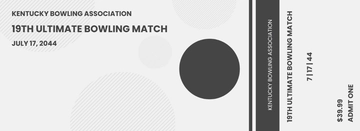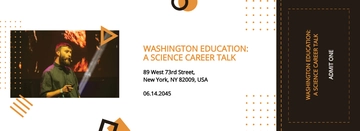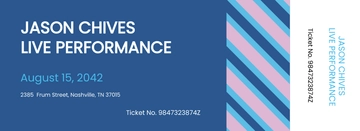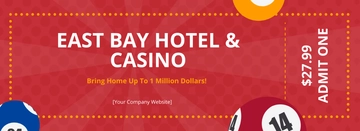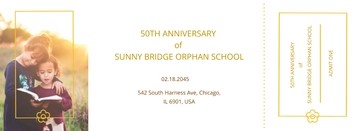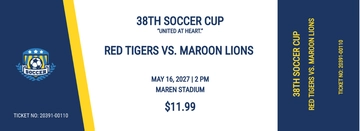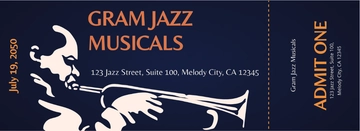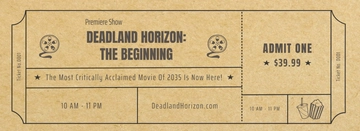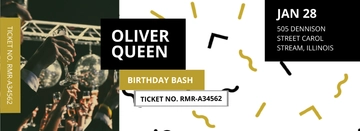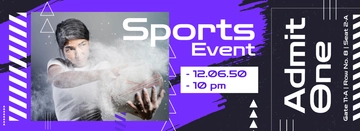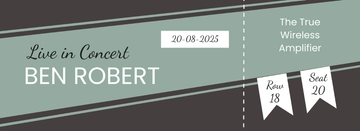Free Event Ticket Advertising Brief
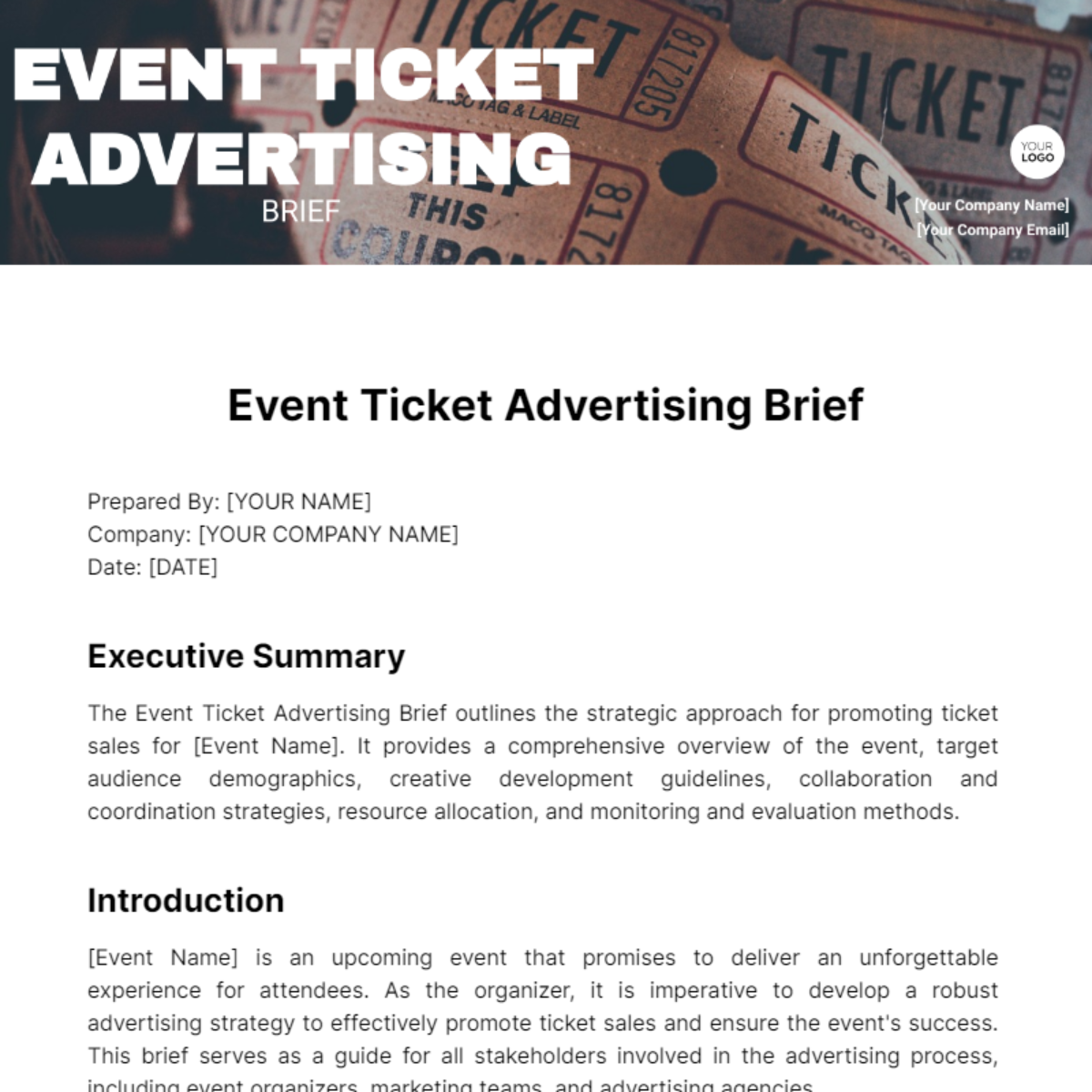
Prepared By: [YOUR NAME]
Company: [YOUR COMPANY NAME]
Date: [DATE]
Executive Summary
The Event Ticket Advertising Brief outlines the strategic approach for promoting ticket sales for [Event Name]. It provides a comprehensive overview of the event, target audience demographics, creative development guidelines, collaboration and coordination strategies, resource allocation, and monitoring and evaluation methods.
Introduction
[Event Name] is an upcoming event that promises to deliver an unforgettable experience for attendees. As the organizer, it is imperative to develop a robust advertising strategy to effectively promote ticket sales and ensure the event's success. This brief serves as a guide for all stakeholders involved in the advertising process, including event organizers, marketing teams, and advertising agencies.
Comprehensive Event Overview
Date: [Event Date]
Venue: [Event Venue]
Performers/Attractions: [List of Performers/Attractions]
Event Description:
The [Event Name] on [Event Date] at [Event Venue] promises an unforgettable experience featuring [List of Performers/Attractions]. With thrilling performances, interactive exhibits, and immersive experiences, attendees of all ages will be captivated. Celebrating diversity and creativity, this event offers networking opportunities and hands-on workshops, fostering community spirit.
Target Audience Demographics and Preferences
Demographic | Characteristics |
|---|---|
Age | Primarily 25-40 years old, young professionals and couples |
Gender | Equally split between male and female |
Location | Urban areas within a 50-mile radius of the event venue |
Income Level | Middle to upper-middle class |
Education | College-educated or equivalent |
Interests and Preferences:
Interests and Preferences | Details |
|---|---|
Music | Fans of various genres, including pop, rock, and electronic dance music. |
Entertainment | Enjoys live performances, concerts, and immersive experiences. |
Social Activities | Interested in socializing and networking opportunities. |
Tech-Savvy | Comfortable with online ticket purchases and mobile apps for event updates. |
Food and Beverage | Appreciates a variety of culinary options, including food trucks and specialty cocktails. |
Health and Wellness | Values health-conscious options, such as yoga sessions or wellness activities at the event. |
How Understanding the Target Audience Informs Advertising Strategies and Messaging:
Understanding the demographics and preferences of our target audience allows us to tailor our advertising strategies and messaging effectively. By aligning our communication with the interests and preferences of our audience, we can create compelling advertisements that resonate with them on a personal level. For example:
Content Selection: Choosing performers and attractions that appeal to our target demographic ensures relevance and interest in our advertising materials.
Channel Selection: Utilizing digital platforms and social media channels popular among young professionals enables us to reach our target audience where they spend their time online.
Messaging Tone: Crafting messaging that speaks to the lifestyle and interests of our audience, emphasizing elements such as entertainment, social experiences, and convenience, will be more engaging and persuasive.
Visual Imagery: Incorporating imagery and visuals that reflect the diversity and vibrancy of our target audience's lifestyle helps create a connection and encourages engagement with our advertising content.
Guiding Creative Development
Key Selling Points:
Unique Performances: Highlight the exceptional lineup of performers, emphasizing their popularity and appeal to our target audience.
Exclusive Experiences: Showcase special features or experiences available only at our event, such as VIP packages or backstage access.
Unforgettable Atmosphere: Communicate the vibrant atmosphere and excitement that attendees can expect, capturing the essence of the event.
Promotional Offers:
Early Bird Discounts: Offer discounted ticket prices for early bird purchasers, incentivizing early ticket sales.
Group Discounts: Provide special rates for group bookings, encouraging attendees to invite friends and family.
Bundle Packages: Create bundled ticket packages that include additional perks or merchandise, adding value for attendees.
Visual Elements:
Captivating Imagery: Utilize high-quality images of performers, venue, and previous event highlights to create visual interest.
Vibrant Graphics: Incorporate bold colors and dynamic designs that reflect the energetic atmosphere of the event.
Consistent Branding: Ensure all visual elements align with the event's branding guidelines, maintaining consistency across advertising materials.
Guidelines for Creative Development:
Brand Consistency: Maintain consistency with the event's brand identity, including logo usage, color schemes, and typography.
Engaging Copywriting: Craft compelling copy that effectively communicates key selling points and resonates with our target audience.
Multimedia Integration: Explore multimedia channels such as videos or interactive elements to enhance engagement and storytelling.
Adaptability: Create adaptable creative assets that can be tailored for different advertising channels and formats, optimizing reach and effectiveness.
Testing and Iteration: Conduct A/B testing and gather feedback to refine creative elements and optimize their performance throughout the advertising campaign.
Facilitating Collaboration and Coordination
To ensure the seamless execution of advertising efforts for [Event Name], collaboration and coordination between event organizers, marketing teams, and advertising agencies are paramount. The following strategies outline how we will facilitate this collaboration:
Regular Communication Channels: Establish regular communication channels such as email, phone calls, or project management platforms to keep all stakeholders informed about the progress of advertising campaigns. Scheduled meetings will be held to discuss strategies, share updates, and address any issues or concerns promptly.
Cross-Functional Teams: Form cross-functional teams comprising members from event organizing, marketing, and advertising departments. These teams will work closely together to ensure alignment of goals, strategies, and tactics, fostering synergy and collaboration throughout the advertising process.
Clear Roles and Responsibilities: Define clear roles and responsibilities for each team member involved in the advertising campaign. This includes roles such as project managers, creative directors, copywriters, designers, media planners, and data analysts. By assigning specific tasks and responsibilities, we ensure accountability and efficiency in execution.
Collaborative Brainstorming Sessions: Organize collaborative brainstorming sessions where all stakeholders can contribute ideas, insights, and feedback. These sessions will encourage creativity, innovation, and cross-pollination of ideas, leading to the development of impactful advertising strategies and campaigns.
Integrated Campaign Planning: Develop integrated campaign plans that outline the timeline, milestones, deliverables, and dependencies for each advertising initiative. This holistic approach ensures that all advertising efforts are coordinated and aligned with the overall marketing strategy, maximizing the impact and effectiveness of the campaigns.
Regular Performance Reviews: Conduct regular performance reviews to evaluate the progress of advertising campaigns against predefined KPIs and metrics. This includes analyzing key performance indicators such as ticket sales, website traffic, engagement metrics, and ROI. Based on these reviews, adjustments can be made to optimize advertising strategies and tactics for better results.
Resource Allocation and Budget Planning
Budget Allocation:
Category | Budget Allocation ($) |
|---|---|
Total Advertising Budget | $50,000 |
Media Planning | $30,000 |
Digital Advertising | $15,000 |
Print Advertising | $5,000 |
Outdoor Advertising | $7,000 |
Social Media Advertising | $3,000 |
Creative Development | $15,000 |
Miscellaneous Expenses | $5,000 |
Media Planning:
|
Resource Allocation:
|
Alignment with Marketing Goals and Objectives:
|
Monitoring and Evaluation
Metrics and Key Performance Indicators (KPIs):
Ticket Sales: Monitor the number of tickets sold daily, weekly, and monthly to gauge the effectiveness of advertising efforts in driving sales.
Website Traffic: Track website visits, page views, and conversion rates to assess the impact of online advertising campaigns on website engagement and ticket purchases.
Social Media Engagement: Measure likes, shares, comments, and click-through rates on social media posts to evaluate audience engagement and interest generated by advertising content.
Email Marketing Performance: Analyze open rates, click-through rates, and conversion rates for email campaigns to determine the effectiveness of email marketing efforts in driving ticket sales.
Advertising Reach and Impressions: Evaluate the reach and impressions of advertising campaigns across various channels, including print, digital, and social media, to assess the visibility and exposure generated.
ROI (Return on Investment): Calculate the return on investment for advertising campaigns by comparing the cost of advertising to the revenue generated from ticket sales.
Procedures for Ongoing Evaluation and Optimization:
Regular Monitoring: Continuously monitor campaign performance metrics to identify trends, patterns, and areas for improvement.
A/B Testing: Conduct A/B testing on advertising creatives, messaging, and targeting to optimize campaign performance and maximize effectiveness.
Feedback Analysis: Gather feedback from attendees, ticket purchasers, and target audience members to assess their perception of advertising efforts and identify areas for enhancement.
Data Analysis: Utilize data analytics tools and platforms to analyze campaign data, identify insights, and make data-driven decisions for optimizing advertising strategies.
Iterative Optimization: Implement iterative optimization strategies based on performance data and insights gained from monitoring and evaluation processes to refine advertising tactics and maximize ticket sales and event attendance.
Collaborative Review: Conduct regular review meetings with stakeholders, including event organizers, marketing teams, and advertising agencies, to review campaign performance, share insights, and brainstorm optimization strategies collaboratively.
- 100% Customizable, free editor
- Access 1 Million+ Templates, photo’s & graphics
- Download or share as a template
- Click and replace photos, graphics, text, backgrounds
- Resize, crop, AI write & more
- Access advanced editor
Revolutionize event ticket advertising with Template.net's Event Ticket Advertising Brief Template. This editable and customizable tool offers precision in crafting captivating campaigns. Seamlessly adjustable within our Ai Editor Tool, it provides flexibility to tailor messages to target audiences. Elevate ticket sales and amplify event visibility with this comprehensive solution, ensuring every detail aligns with your brand's vision.
You may also like
- Admission Ticket
- Admit One Ticket
- Airline Ticket
- Banquet Ticket
- Baseball Ticket
- BBQ Ticket
- Birthday Ticket
- Blank Ticket
- Boarding Pass Ticket
- Christmas Ticket
- Church Ticket
- Cinema Ticket
- Circus Ticket
- Concert Ticket
- Ticket Design
- Dinner Ticket
- Drink Ticket
- Editable Ticket
- Event Ticket
- Exit Ticket
- Festival Ticket
- Food Ticket
- Football Ticket
- Fundraiser Ticket
- Gift Ticket
- Golf Ticket
- Graduation Ticket
- Halloween Tickets
- Meal Ticket
- Movie Ticket
- Music Ticket
- Parking Ticket
- Party Ticket
- Printable Ticket
- Raffle Ticket
- Retro Ticket
- Sports Ticket
- Tennis Ticket Templates
- Train Ticket
- Travel Ticket
- VIP Ticket
- Wedding Ticket







